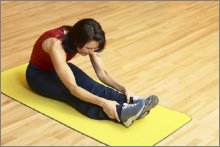The Nine Best Exercises for You if You Have Aching Joints
by www.SixWise.com
Joint pain is one of the most common complaints among Americans,
according to Health United States, 2006, released by the Centers
for Disease Control and Prevention's (CDC) National Center
for Health Statistics.
|

Low-impact exercises, like swimming, bike riding and
walking, are ideal for people with any type of pain,
including joint pain.
|
About 10 percent of U.S. women, and 7 percent of U.S. men,
say they have severely painful joints, with the knee being
the joint that causes the most pain.
While reports of severe joint pain increase with age, according
to the National Center for Health Statistics, aging itself
does not cause joint pain.
Some common causes of achy joints include rheumatoid
arthritis, osteoarthritis, overuse of the joint, injury
to the joint and bursitis.
Because joint pain can make even everyday tasks painful,
the very nature of the ailment can cause people to give up
all forms of exercise.
Yet, exercise is one of the most beneficial things you can
do for your overall health -- and your joint health -- and
it's just
as important as you get older as it is when you're young
(if not more so).
And while it's important to rest painful joints when they
feel fatigued, exercise is actually beneficial for joint pain.
A lack of exercise, meanwhile, can cause your joints to become
even more painful and stiff.
According to the Mayo Clinic, exercise can:
-
Strengthen the muscles and tissues around your joints
-
Help you maintain bone strength
-
Give you more strength and energy
-
Help you control your weight, which also takes pressure
off of your joints
Exercise also works to relieve pain by prompting your body
to release chemicals called endorphins that actually block
pain signals from reaching your brain.
|

Stretching is something that you can do daily to strengthen
your joints and relieve pain. To learn 15 of the most
effective stretches that take just 15-20 minutes a day
to do, check out Jacques Gauthier's Stretching
Toward a Healthier Life DVD.
|
"Endorphins are the body's natural pain-relieving chemicals
that in many cases are more powerful than morphine,"
says Edward Laskowski, M.D., a physical medicine and rehabilitation
specialist and co-director of the Sports Medicine Center at
Mayo Clinic, Rochester, Minn.
The Best Exercises for People With Achy Joints
Lower impact exercises are the best for people with achy
joints simply because they're easier on your joints than higher
impact varieties. Fortunately, there are a wide variety of
options out there, so you'll be able to find several that
appeal to you.
Range-of-Motion Exercises
These help to increase your flexibility, relieve stiffness
and maintain normal joint movement, and should be done daily.
-
Yoga
-
Dance
-
Stretching
Stretching is particularly effective because it's known to
give your joints a better range of motion, may slow the degeneration
of your joints, and it helps to relieve
pain.
To learn how to do the right type of stretching -- the kind
that actually feel good while you do them (and after!) --
we highly recommend the Stretching
Toward a Healthier Life DVD.
In the video, stretching expert Jacques Gauthier and his
wife Dorothee Lavoie present 15 stretches that stretch all
the key muscles groups throughout your entire body, and it
only takes about 15-20 minutes per day total to do the complete
stretching routine. Anyone who's suffering from pain should
make the stretches in this video a priority.
Aerobic and Endurance Exercises
These can reduce inflammation in your joints and help control
your weight. Strive to do these for 20 or 30 minutes, three
times a week.
-
Walking
-
Bike riding
-
Elliptical machine
-
Swimming
-
Cross country ski machine
Strengthening Exercises
Strength training helps to keep your muscles strong, which
will support and protect your joints. Do these every other
day, but listen to your body. If your joints feel tired or
painful, give yourself an extra day off.
(See
important Weight Training article for details!)
Tips for Protecting Your Joints While You Exercise
To make sure your exercise routine is beneficial to your
joints, you should take extra care to protect your joints
while you exercise by:
-
Putting a hot pack on the joints you'll be working out
before you exercise (for about 20 minutes). This will
help to relax your joints and relieve pain before you
begin.
-
Stretching or gently warming up your joints before your
workout.
-
Using gentle, gradual movements, not jerky ones, while
you exercise.
-
Taking a break if you notice pain (beyond your normal
pain).
-
Applying a cold pack to your joints (for 10-15 minutes)
after you exercise to reduce any swelling or pain.
Recommended Reading
Can
Joints and Knees that Ache Really Predict a Change in the
Weather?
Physical
Pain: 8 Non-Drug Tactics to Eliminate Back, Joint & Other
Pain
Sources
Centers
for Disease Control and Prevention Media Relations November
15, 2006
MayoClinic.com